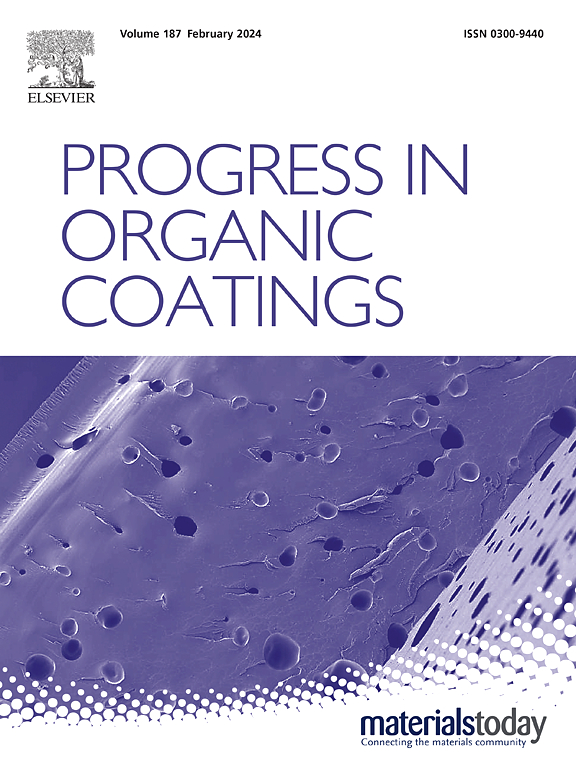Hydrophobic and self-healing anti-corrosion coatings based on hybrid attapulgite-Ce-MOF pigment
IF 6.5
2区 材料科学
Q1 CHEMISTRY, APPLIED
引用次数: 0
Abstract
This study highlights the combined effect of a 2-methylimidazole cerium-based metal-organic framework (Ce-MOF) developed in situ on attapulgite (ATP) as a nano-hybrid inhibitor pigment (ACE). Hydrolytic condensation impregnated the ACE nanocomposite with a polysiloxane (POS) layer, resulting in the hydrophobic POS@ACE nanocomposite. Immersion studies on AA2024-T3 in a 3.5 wt% NaCl solution with nanocomposite demonstrated an inhibition efficiency (I.E.) of ∼99 %. The novel hydrophobic intelligent polyurethance (PU) coating (PU/POS@ACE) with varied concentrations (1, 3, 5, and 10 wt%) was formulated to examine its anti-corrosion properties. The findings show that after 45 days of electrochemical tests, PU/POS@ACE-10 % maintains the highest |Z|0.01Hz value of 4.89 GΩ cm2 and shows a 375 % increase in |Z|0.01Hz compared to the blank PU under artificial scratch. This can be attributed to the release of Ce3+/Ce4+, which could generate insoluble passivation films at the alloy/coating interface. The modified coating exhibits substantial hydrophobicity, that ensures long-term anti-corrosion performance. MD-simulation shows strong binding energy (−7.054 eV) between the Ce molecule and Al (111) surface, and the charge distribution profile also shows strong chemisorptive integrity. This study proposes a new design strategy for green Ce-MOF nanocomposites for the development of intelligent protective coatings capable of tolerating distinct service environments.

求助全文
约1分钟内获得全文
求助全文
来源期刊

Progress in Organic Coatings
工程技术-材料科学:膜
CiteScore
11.40
自引率
15.20%
发文量
577
审稿时长
48 days
期刊介绍:
The aim of this international journal is to analyse and publicise the progress and current state of knowledge in the field of organic coatings and related materials. The Editors and the Editorial Board members will solicit both review and research papers from academic and industrial scientists who are actively engaged in research and development or, in the case of review papers, have extensive experience in the subject to be reviewed. Unsolicited manuscripts will be accepted if they meet the journal''s requirements. The journal publishes papers dealing with such subjects as:
• Chemical, physical and technological properties of organic coatings and related materials
• Problems and methods of preparation, manufacture and application of these materials
• Performance, testing and analysis.
 求助内容:
求助内容: 应助结果提醒方式:
应助结果提醒方式:


